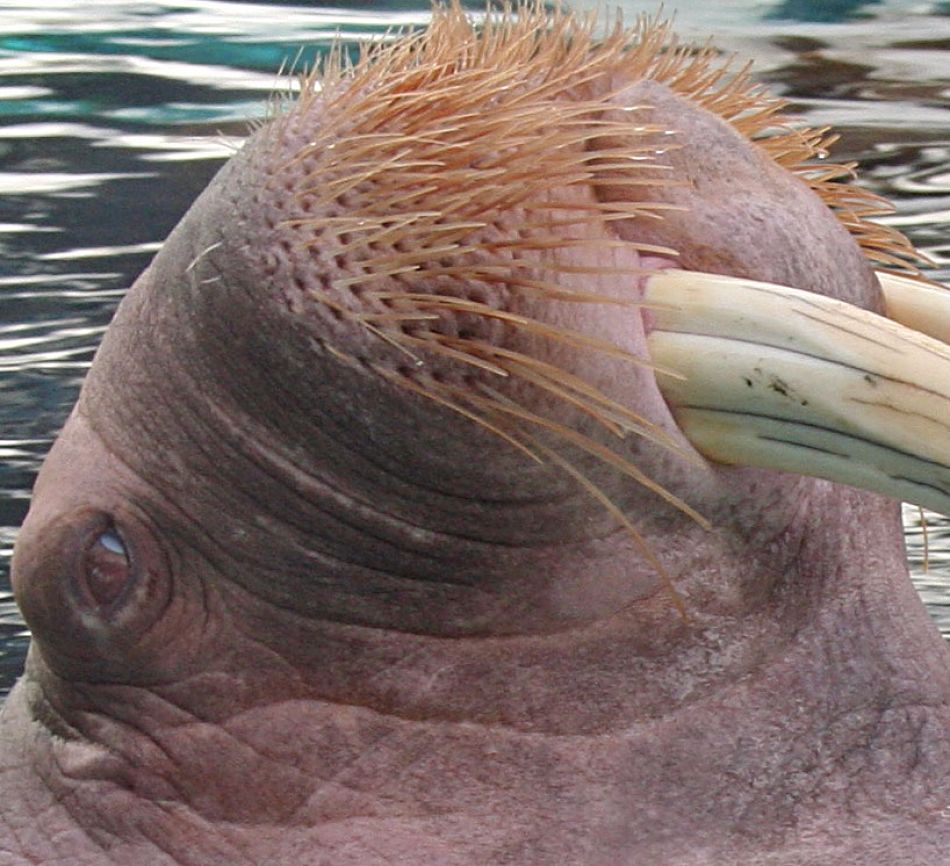walrus Facts
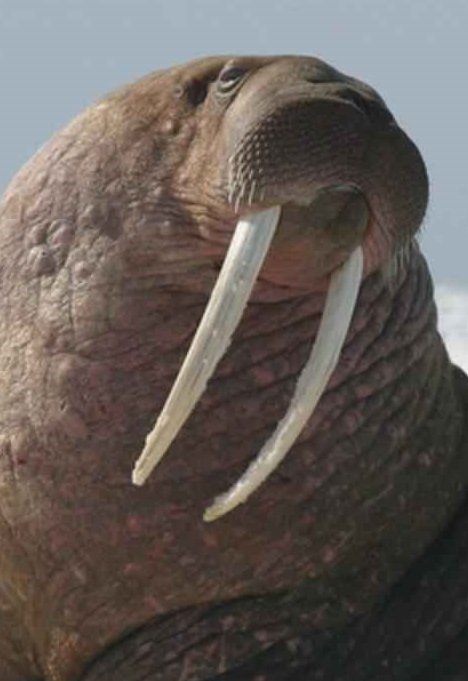 Portrait of a Walrus
Portrait of a WalrusOne of the most interesting walrus facts, is that they are one of the world's most social animals, spending about a third of their lives sleeping right on top of each other. The walrus is an aquatic carnivore with a voluminous body that has been specially designed for life in a frozen environment.
Walruses can be found in the icy oceans of the North Pole at the top of the world, in places like Canada, Alaska, Russia, Greenland and Scandinavia.
The walrus is a member of the seal or pinniped family. The word pinniped means "flipper feet" or "feather feet". Within the pinniped family are three types of semi-aquatic marine mammals, the "true seals", the "eared seals" and the walrus.
The walrus is alone in its own genus, and there are 2 main species. The Atlantic walrus can be about 8 feet long and 2,000 pounds, while the Pacific walrus is larger, averaging about 10 feet long, with individuals topping 14 feet long and around 4,000 pounds.
It is actually believed that the walrus descended from a 3 foot long, bear-like animal that lived on land some 10 million years ago, and somehow during its evolutionary journey, returned to the ocean where its limbs slowly became flippers. Walrus flippers are short and square with all the skeletal features of a terrestrial forelimb, including five fully formed digits, but the digits are completely webbed. Each digit has a small nail, and the underside of the flippers are thick and roughened for traction on ice and snow.
Living in some of the coldest regions of the world, the walrus is equipped with nearly 1 inch of thick, wrinkled skin, and a blubber layer right underneath that can be almost 6 inches thick. Some mature males develop large, mole-like nodules called "bosses" over the skin of their necks, giving them a warty texture.
The skin color of the walrus changes as the animal moves from land to sea, and those changes are particularly evident on mature and older walruses who have thinning hair. The walrus is able to dive to depths of over 300 feet because of special adaptions that conserve oxygen.
On a deep dive, the blood retreats from the animals extremities and surrounds the brain and vital organs. The skin grows paler the longer the walrus is underwater, and on long diving binges, the walrus may even look white. Once they return to land, the blood begins to flow freely again, and the skin looks brown. When the walrus sunbathes for extended periods of time, the blood moves closer to the skins surface to be warmed, and the walrus will take on a pink hue.
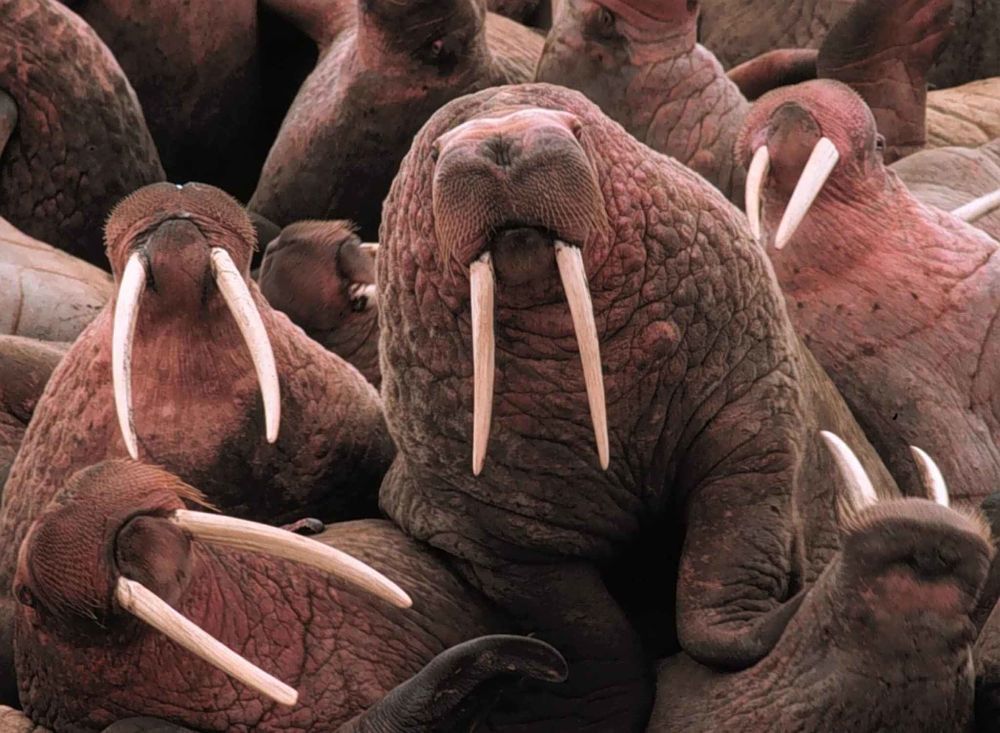
The entire body of the walrus is shaped for water travel, starting with a small, flat-topped head, widening out to hulking shoulders, and narrowing again, like a huge spindle, to the rear flippers. Most of the underwater propulsion comes from the rear flippers, with the front flippers kept close to the sides and used only occasionally for steering and extra boost.
Getting around on land requires stepping with the front flippers and then writhing the big torso forward, and may be assisted by stabbing the ice with the tusks and pulling. This is why the Latin name for the walrus translates roughly to "tooth walker".
The tusks are enlarged canine teeth, and both males and females grow them, although the males can be quite a bit larger. Babies are born without tusks, but they begin to grow out of the gums at about 6 months old, and will start to appear from under the top lip at about 14 months.
They are thought to continue growing for the first 15 to 20 years of a potential 40 year lifespan, and massive tusks mean high social rank. In fact, an established walrus that breaks a tusk will quickly loose its status.
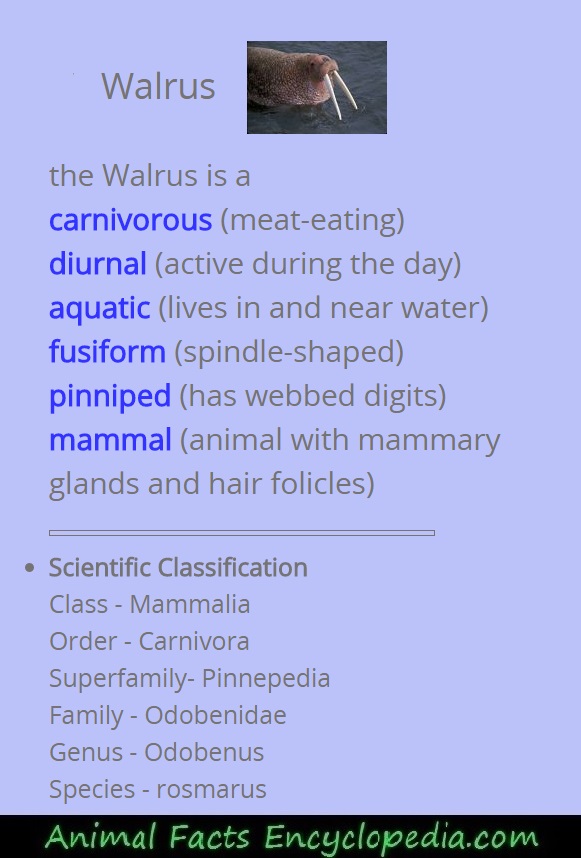
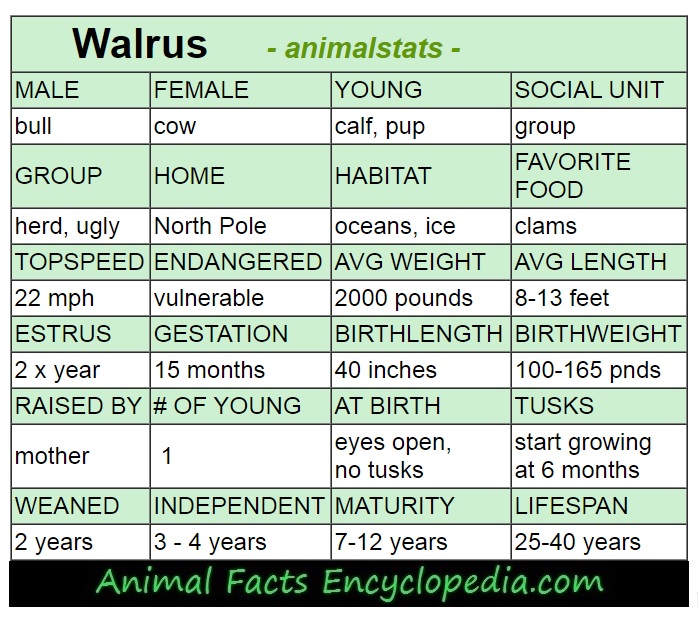
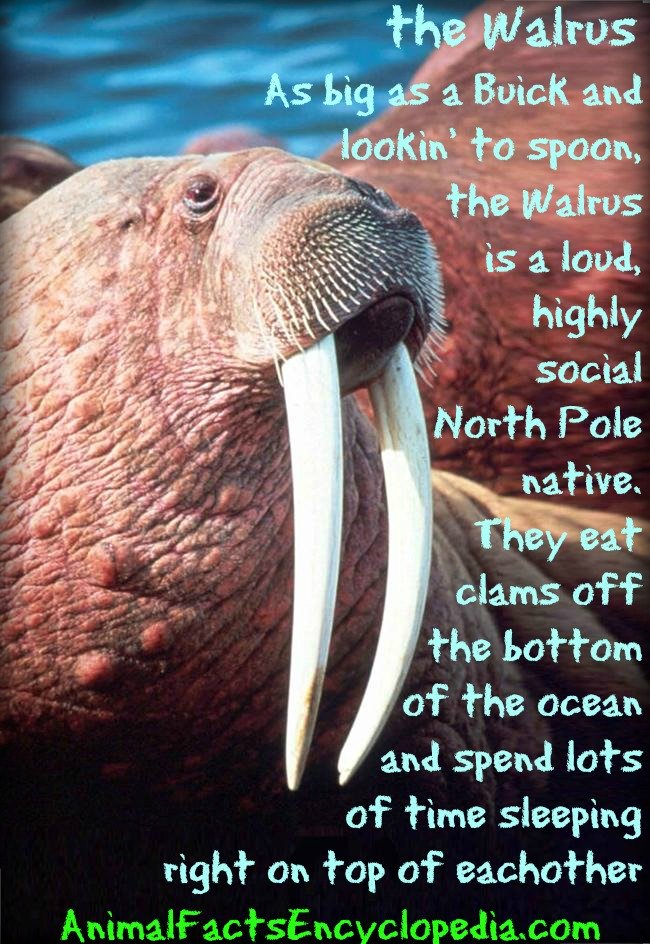
walrus lifestyle
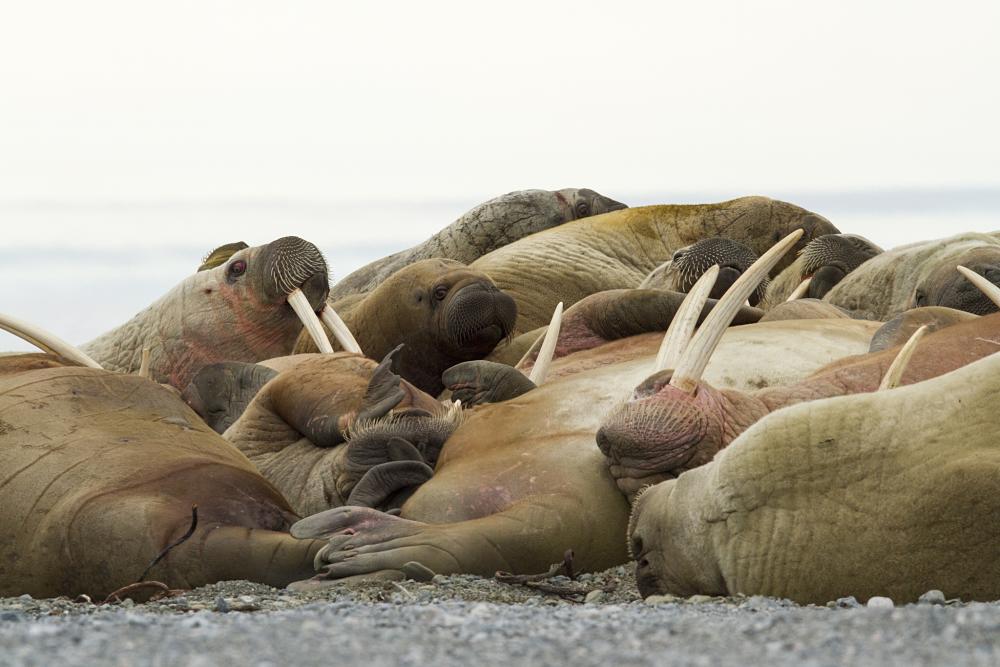
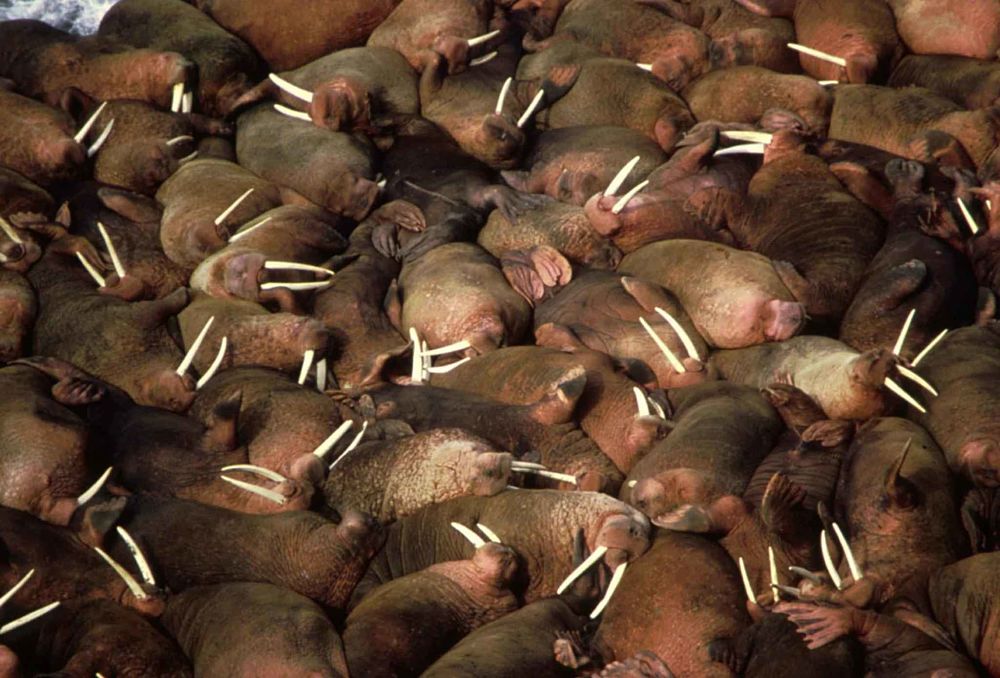
Walruses are carnivores that eat virtually no plant material. They occasionally hunt small seals, and sometimes individual males will become very successful with that strategy. There have even been numerous accounts of two or more walruses teaming up to hunt together.
But mostly, the gigantic walrus feeds on very small creatures located in the environment of the sea floor known as the benthic zone. Clams and mollusks are their preferred snack, but sea cucumbers, worms, shrimp and fish are consumed as well, and the walrus can eat several thousand individual organism in a single feeding.
The wonderful face full of whiskers that gives the walrus such character, is a hunting tool. The whiskers are tactile hairs known as vibrissae, which are used to troll the sandy sea bottom. If the walrus finds something that needs to be dislodged, it will spit a jet of water into the crevice and knock the morsel free. When eating clams, the walrus uses great suction power, sucking the meat out and spitting the shell out.
Walruses will skim along the ocean floor with their tusks parallel to the bottom and their whiskers busy kneading through the substrate. They use their tusks as sled runners, and rest on them as they go.
Although it would seem to make sense, recent research shows walruses do not use their tusks when foraging in the deep sea. In fact, the main use of the tusks is to help the walrus haul itself up out of the water and onto an iceberg.
As they approach the edge of an iceberg, which may be sticking out of the water a few inches or a few feet, the walrus throws its head back and stabs the surface with its tusks, using them to lever itself out of the water.
Its a pretty slick move, and when you see a mass like that wrenching itself from the ocean in a single motion you realize the simple utility of the incredible tusks. Naturally they are used for other things, like defense, scratching and as a measure of maturity and social status, but they are used most often as a kind of glorified shoehorn.
The walrus is an extremely social animal which seems to desire and take comfort in the closeness of the herd. Their lives are dictated by their need for lots of food, and they generally have schedules of eating that are pretty extreme. They will swim out to their feeding areas, dive up to 330 ft down to the bottom, although 80 to 200 foot dives are most common, and feed for 5 to 12 minutes at a time, and then return to the surface to breathe and rest.
These dives are amazing feats of engineering, where the blood moves away from the extremities and is concentrated around the brain and vital organs, while the blubber layer insulates, and the heartbeat slows to conserve heat.
When they come back up to breathe, they redirect air into large chambers in their throats called ‘pharyngeal pouches’ that inflate and act like life preservers. With these pouches inflated they can rest effortlessly on the surface, and will even sleep in the water with their heads tossed back, bobbing dreamily.
The pharyngeal pouches are used as a way to communicate as well. Air can be pushed back and forth between the two chambers making a bell-like sound called "chiming". Another body part noise maker are the walruses very large flat teeth. They will chatter their jaws together and make a sound called "clacking" that sounds like drums.
Walruses may spend 60 to 80 hours at sea feeding continuously, and then return to shore to haul out and rest, one on top of the other, in piles of dozens or hundreds of individuals, for 3 or 4 days straight.
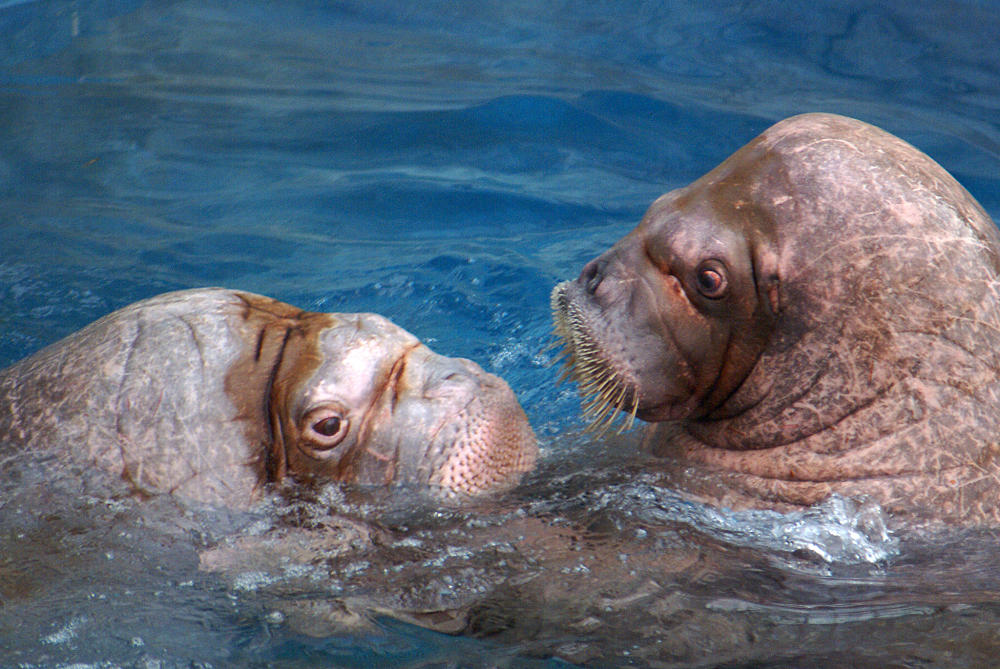 playing walruses
playing walruseswalrus facts on reproduction

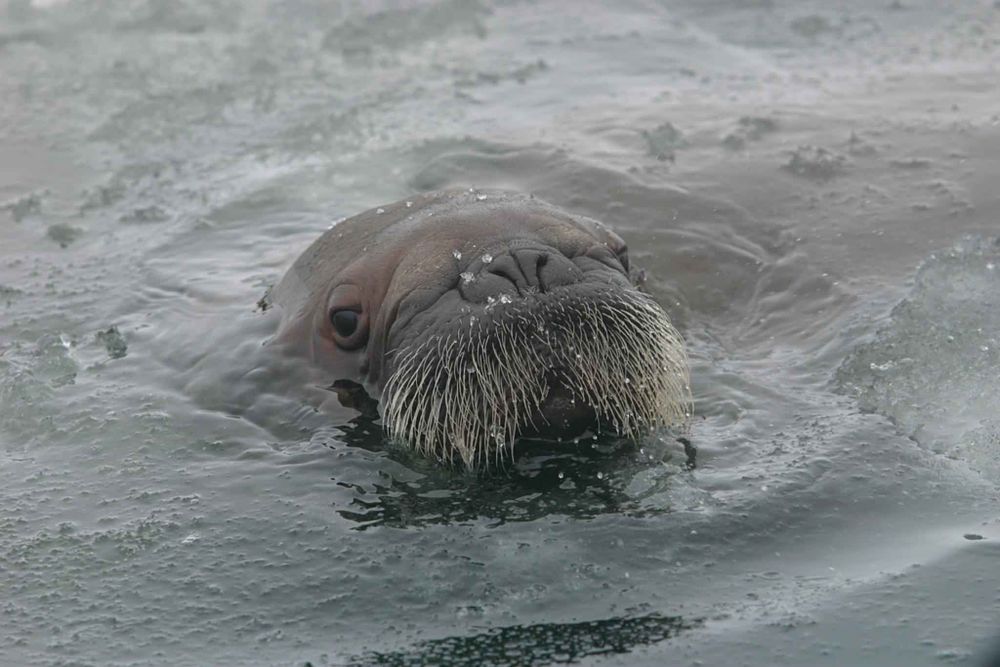 baby walrus
baby walrusWalruses live in huge herds of sometimes several thousand individuals, but these herds are separated by sex, and only come together once a year to mate. Females in estrus will gather in groups on the beach, and males will stake out territories on the coastline and try to attract them. Bulls will display by throwing their heads back and freezing with their tusks in the air, and making chiming noises by pushing air back and forth in their pharyngeal pouches.
They may fight with other bulls, using their tusks, and wrestling with each other. Immature bulls, and older or weaker males will remain in their herd and not participate.
A bull must be in peak condition with fully developed tusks in order to attract females, and they won't generally be interested until he is about 15 years old. Cows won't mate until they are about 8 years old, and these long development times give the walrus a very slow reproductive rate, so it is difficult to maintain stressed populations.
Mating may occur both on land and in the water and then the female returns to her herd.
The walrus has a process of delayed implantation, which means the embryo does not start to develop until it has been in the womb for about 4 months. This ensures the youngsters will be born at the most ideal time of year, when food is plentiful.
The entire pregnancy lasts about 15 months, but the baby actually grows for only 11 months. The mother will usually seek a private ice float when she's ready to give birth. A newborn walrus, known as a pup or a calf, may weigh 100 to 150 pounds. Baby walruses are well developed when born with fur and open eyes, and they can swim within about an hour.
Daughters or other female relatives, may join the new mom and can be very protective and maternal. Female walruses have been known to adopt orphans, and the walrus mother is exceptionally loving and cuddly. She will exchange kisses, and hold the baby in her flippers while floating in the water.
The baby stays very close, both on land and at sea, and if their are aunts around, they will surround the baby and form a shield of protection, especially while swimming.
When babies are small, they may ride on their mothers back, balancing with their little flippers. They are born without tusks, but they cut through the gums at 5 or 6 months.
The baby may start to forage on the ocean floor by 6 or 7 months old, but may continue to nurse for up to 2 years.
Walrus mothers are fiercely protective and will actively fight polar bears to protect their young. The polar bear is the babies primary threat, but killer whales will prey upon them as well.
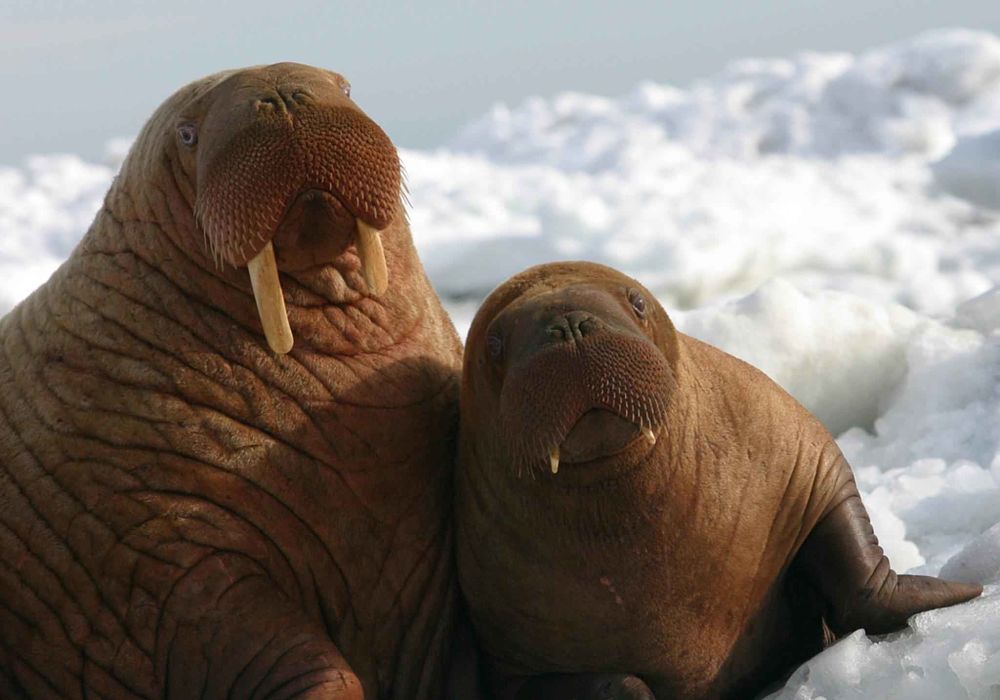 walrus mother and baby
walrus mother and babythe endangered walrus
Global warming has all sorts of negative effects on the world and its creatures. Some scientists believe that the Arctic could be entirely without ice during the summer months within 20 to 25 years. Walruses are bottom feeders who forage for invertebrates in the relatively shallow waters off the coasts.
When not feeding they spend much of their time on sea-ice. Mother walruses give birth on sea ice in the springtime. Mothers depend on the sea ice for safety from predators as they raise their calves. The problem the melting ice cap poses for walruses is that the distance between the sea ice where they live for much of the year, and the coastlines where they feed is increasing as the ice margins recede.
For some mothers with youngsters, it means the babies aren't strong enough to make the trip back and forth. And mothers are forced to come ashore with their babies, where they can fall prey to hunters and polar bears. This scenario is becoming more and more true for adult walruses as well. Some herds numbering between 20,000 and 35,000 came ashore in Alaska in 2014 and 2015.
These were the first haul-outs of this size seen, and it appears the problem is only getting worse. Some scientists believe that by the year 2035, there will be no sea ice left in these areas during the summer months, which could spell disaster for the walrus. As of 2015 the population of the Pacific walrus is less than 200,000 individuals, but the Atlantic walrus is in greater danger, with less than 25,000 Atlantic walruses in existence.
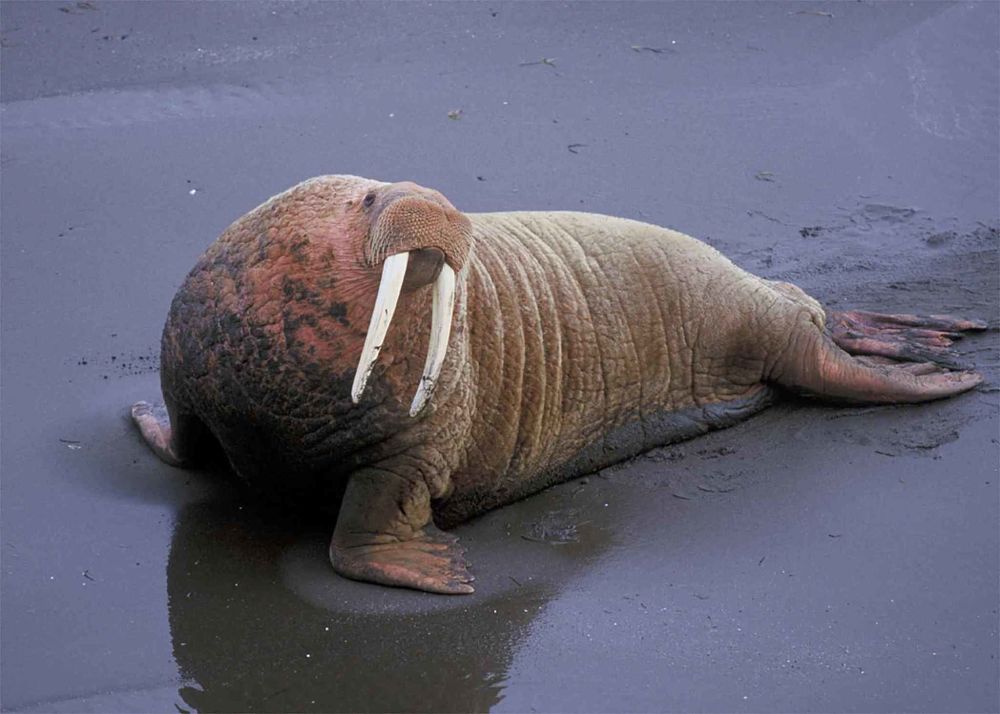

a few more walrus facts
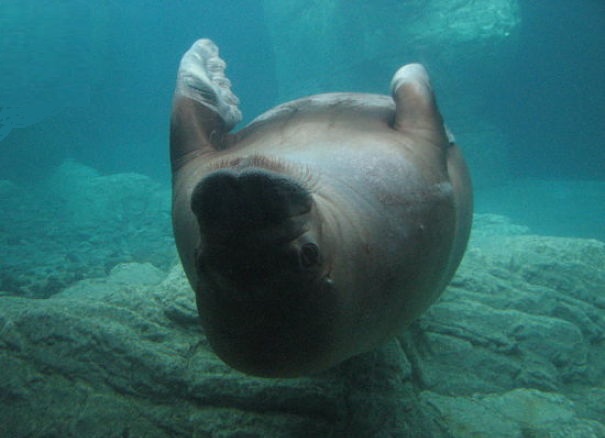
- The walrus can dive to depths of over 300 feet
- Walruses use their tusks to pull themselves up onto icebergs
- The tusks of a male walrus can grow up to 40 inches
- Walruses have 1 inch think skin
- Walruses have 6 inch thick blubber
- The walruses Latin name means tooth-walker
- Walruses live in the oceans around the North Pole
- The walrus eats hundreds of clams a day
Scientific Classification:
| Walrus - animalstats - | |||
|---|---|---|---|
| MALE | FEMALE | YOUNG | SOCIAL UNIT |
| bull | cow | calf, pup | group |
| GROUP | HOME | HABITAT | FAVORITE FOOD |
| herd, ugly | North Pole | oceans, ice | clams |
| TOPSPEED | ENDANGERED | AVG WEIGHT | AVG LENGTH |
| 22 mph | vulnerable | 2000 pounds | 8-13 feet |
| ESTRUS | GESTATION | BIRTH LENGTH | BIRTHWEIGHT |
| 2 x year | 15 months | 40 inches | 100-165 pnds |
| RAISED BY | # OF YOUNG | AT BIRTH | TUSKS |
| mother | 1 | eyes
open, no tusks |
start growing at 6 months |
| WEANED | INDEPENDENT | MATURITY | LIFESPAN |
| 2 years | 3 - 4 years | 7-12 years | 25-40 years |
see more animal extreme closeups
Recent Articles
-
African Animals - Animal Facts Encyclopedia
Oct 11, 16 10:27 PM
African Animals facts photos and videos..Africa is a wonderland for animal lovers, and a schoolroom for anyone who wants to learn about nature, beauty and the rhythm of life -
Baboon Facts - Animal Facts Encyclopedia
Oct 11, 16 10:26 PM
Baboon facts, photos, videos and information - Baboons are very distinctive looking monkeys with long, dog-like snouts and close set eyes. -
Great Apes Facts - Animal Facts Encyclopedia
Oct 11, 16 10:25 PM
Great apes facts, photos and videos..Human beings did not evolve from chimpanzees, modern chimps and gorillas do not appear in the fossil records until much more recently than homo sapiens..




















